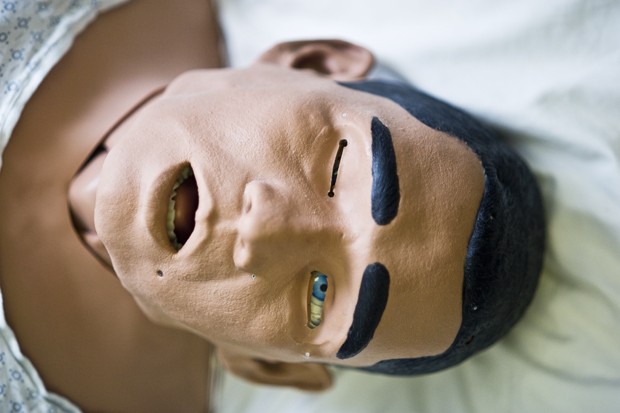âÄúOw, that hurts!âÄù he whined. His fingertips turned blue and he began to cry and mumble incoherently. The other occupants of the tiny room in the Mayo Memorial Building, an infant and a man covered head to toe by a sheet, did not blink. Their power switches were turned off. These âÄúSimMenâÄù âÄî reactive manikins created for students to practice surgery, anesthesia, trauma and image-guidance skills, faced a new set of scalpels as surgery students began practicing in the SimPORTAL last week. Different departments of the Medical School continuously rotate through the simulation lab, where they primarily âÄútrain for rare events they wouldnâÄôt normally have exposure to,âÄù said Dr.Burak Argun, the CenterâÄôs first international surgical simulation fellow . Students work in teams. The dummies are run by SimPORTAL staff and teachers who regulate everything from blood pressure to if the dummy seizures. âÄúItâÄôs like the Wizard of Oz with the man behind the screen,âÄù Director of Operations for SimPORTAL Troy Reihsen said. After the procedure, teachers debrief students and question procedural tactics. SimPORTALâÄôs Curriculum and Assessment Council integrated this active learning into the Medical SchoolâÄôs curriculum. âÄúFor too long itâÄôs been a faculty member standing at the bottom of a big auditorium talking âĦ We can teach people a lot more effectively by engaging them,âÄù said Jane Miller, Director of the Interpersonal Education Resource Center and a member of the Curriculum Council . Students are not required to spend a certain number of hours in lab. âÄúThereâÄôs no magic number. Instead of looking at numbers, we try to train people to proficiency,âÄù Miller said. Efficiency has increased, as medical students âÄúcan be trained on psychomotor skills to the capability of a third-year resident in six months,âÄù Reihsen said. In a profession where errors like a punctured lung can be grave, students can practice in the lab without fear, Argun said. And once the students have mastered the basics, like how to tie a knot when stitching a wound, they can focus on ethical decisions like where to tie it, Reihsen said. Each lab experience is tailored to the residentsâÄô experience level, just as medical procedures are tailored to the patient. Personalizing procedures is another focus of SimPORTAL and the associated Center for Research in Education and Simulation Technologies. âÄúThe human body acts different in different situations, itâÄôs not like a Boeing Airplane where we built it, so we know how it works,âÄù said Argun. Research into a new portable simulation might help doctors prepare for variation between patients. Using a CT Scan, doctors could create a patient-specific 3-D model of the body to manipulate and study before a procedure, SimPORTAL Director Robert Sweet said. At CREST, staff from the Academic Health Center develops new training technology and conducts research on the effectiveness of simulations in nursing, dentistry, medicine and public health, Miller said. Sweet, who is also the director of CREST, said future research should look into a human factors lab. The lab would create an optimal working environment for medical residents by studying how internal and external factors like âÄúdid you drink coffeeâÄù or âÄúare you cold?âÄù affect their performance. Last Thursday SimPORTAL staff applied for a grant from the Recovery Act Limited Competition: Extramural Research Facilities Improvement Program that would fund an Institute for Simulation Sciences, which would house both CREST and SimPORTAL. Sweet said the institute could be in place this winter if they receive the grant.
Simulators prepare medical students
SimPORTAL lab houses preparative technology spanning the medical field.

Image by Jules Ameel
A METI iStan mannequin lies in the SimPORTAL ward of the mayo building on Friday. The METI iStan acts like a real patient with real sounds, bleeding, and even tear ducts for medical students to practice on in a less stressful situation.
Published July 14, 2009
0
More to Discover







